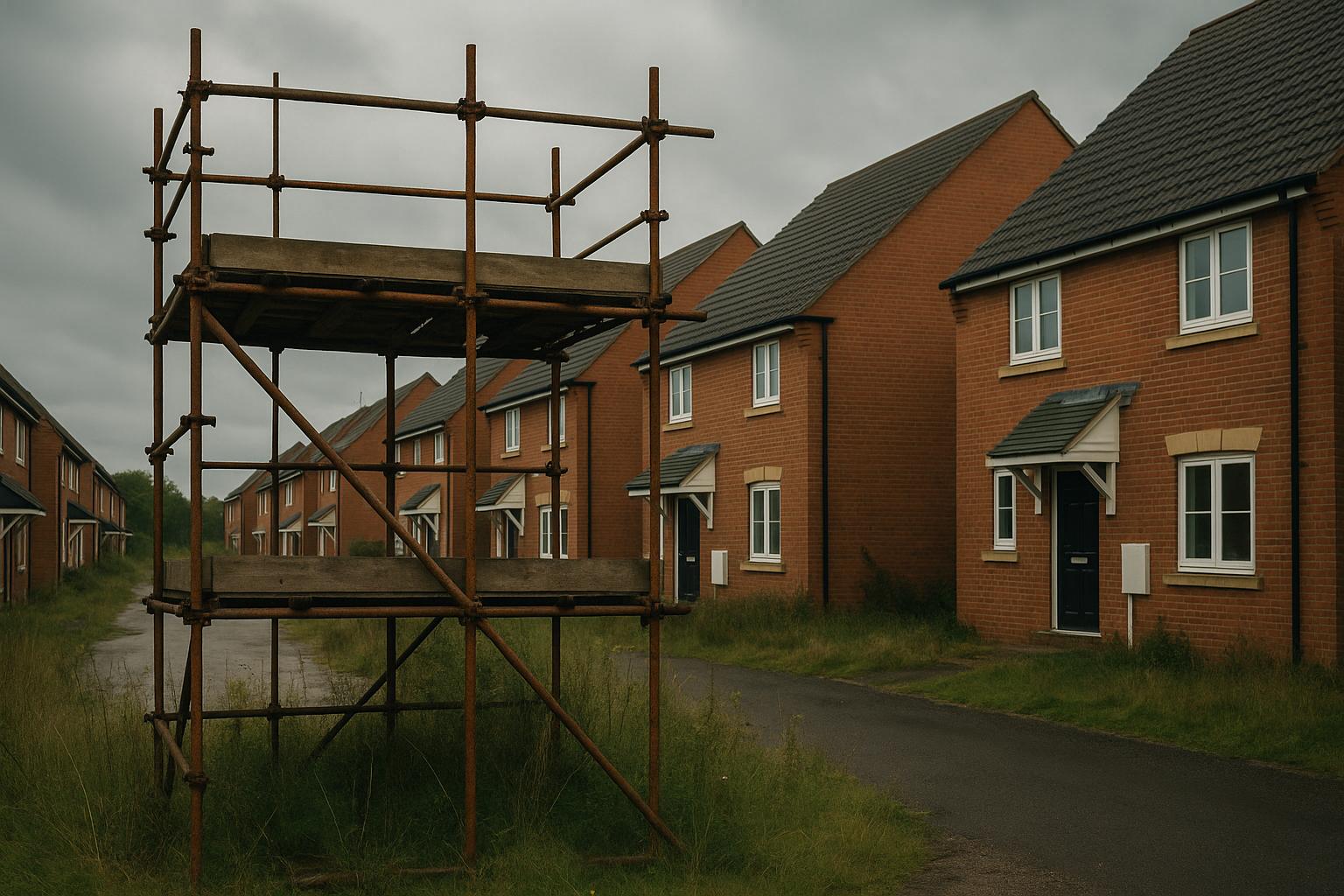The UK construction and housing sectors are currently facing a pronounced slowdown, with significant declines in residential projects striking across public and private domains. Data from industry analyst Glenigan reveals that housing construction starts dropped by 18% compared to the previous quarter, finishing 16% below levels seen in early 2024. This downturn is compounded by a sharp 48% plunge in detailed planning approvals relative to the previous three months and a 17% decrease compared with the previous year. Newly released government figures also report a 5% year-on-year decline in overall planning applications submitted between April and June 2025, with local authorities receiving 11% fewer applications compared to the preceding quarter.
This residential sector weakness is mirrored in the outlook among architects. The Royal Institute of British Architects (RIBA) recorded a softening future workload index in August 2025, dropping from +9 in July to just +2, alongside average workloads 13% lower than the same period in 2024. These indicators are largely attributed to a steep decline in the private housing market—the primary revenue source for smaller architectural practices. Adrian Malleson, RIBA’s head of economic research, attributes the downward pressure to a constellation of factors including rising costs, weak client confidence, a stagnant economy, regulatory burdens such as the Building Safety Act, and persistent planning delays.
The housing slowdown has prompted government action, with Housing Secretary Steve Reed labelling the fall in planning applications as "unacceptable" and unveiling a 'building acceleration package' intended to expedite new home construction. Nevertheless, industry voices emphasise that planning system delays disproportionately affect small and medium-sized developers, exacerbating the housing crisis. Motti Ifergan, director of UPP Architects and a town planner, stresses the need for investment in planning teams, policy clarity, and faster decision-making to unlock housing supply.
Glenigan’s September Construction Index further paints a bleak picture, reporting a 24% reduction in social housing project starts in the latest quarter and a 17% decline year-over-year. Private housing is similarly affected, with new onsite projects down 16% from the previous year. Contrastingly, non-residential sectors show some resilience, especially office building starts, which surged by 103% in the quarter and more than doubled compared to last year. Glenigan’s economist Drilon Baca suggests the industry is still in a significantly stronger position than the previous winter, although disappointment remains among firms given the prior quarter’s false optimism.
This protracted housing construction weakness is not new; February 2025 data highlighted through the S&P Global/CIPS Construction PMI revealed the sector’s steepest contraction since 2020. Housebuilding outpaced the general construction slowdown with output, employment, and new orders all notably declining. Analysts and commentators from various construction consultancies underscore the importance of reforming the planning system, identifying it as a major barrier to government ambitions for housing growth.
Economic factors contribute additional headwinds. Barratt Redrow, the UK’s largest homebuilder, has warned that uncertainties surrounding the upcoming November 2025 budget could heighten risks to home sales for fiscal 2026. CEO David Thomas pointed to inflation, high interest rates, weak consumer confidence, and speculation over potential stamp duty hikes as factors straining the market, although he remains optimistic about the housing market’s long-term fundamentals. Despite these challenges, Barratt Redrow reported strong financial performance for the year ending June 2025, with revenue rising to £5.58 billion and profits surpassing expectations.
Meanwhile, UK housing prices showed signs of strain in September 2025, with the first yearly decline since early 2024. Asking prices dipped 0.1%, driven predominantly by southern England, where higher-value properties are sensitive to tax change speculation in the forthcoming budget. Rental market growth has also slowed to its weakest pace in four years, with rents rising just 2.4% annually amid increased availability and easing demand pressures. These trends are compounded by stalled economic growth and expectations that interest rates will remain steady at 4% for the near term.
The pipeline of new homes further underscores concerns about future supply. Industry bodies report that the 12 months to Q1 2025 saw just over 204,000 completions—down 9% from the previous year and the lowest annual figure since 2016. While larger housebuilders have seen some quarterly gains in completions, smaller firms continue to struggle, delivering fewer new homes—a trend mirrored in sharp declines in housing starts on site and shrinking numbers of homes under construction. The housing delivery test, a government mechanism for ensuring local authorities meet development targets, is expected to see more districts failing, increasing the risk of developmental sanctions albeit highlighting systemic supply challenges.
Land and planning remain prominent constraints, with over half of developers citing land prices as a significant hurdle despite some easing in land availability issues. Notably, the government’s ongoing reform promises and additional housing funding from earlier statements aim to mitigate these blockages over time.
In sum, while the UK construction sector shows pockets of improvement outside housing, the residential market continues to falter amid economic headwinds, planning system inefficiencies, and market uncertainties. The sector’s recovery appears dependent on accelerated government interventions in planning reform and sustained economic support to stem declining starts and deliver on critical housing targets.
📌 Reference Map:
- Paragraph 1 – [1], [6]
- Paragraph 2 – [1]
- Paragraph 3 – [1]
- Paragraph 4 – [1], [6]
- Paragraph 5 – [4], [5]
- Paragraph 6 – [2]
- Paragraph 7 – [3]
- Paragraph 8 – [7]
Source: Noah Wire Services
